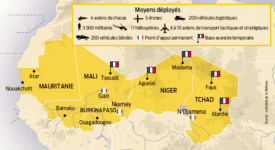The Sahel is characterized by weak and failed states that are unable to provide security and economic redistribution for their citizens, which has, in turn, led to the fostering of all kinds of illegal economic activities. Many argue that, in this context, radical jihadi organizations in the Sahel have been able to maintain themselves by establishing links with different kinds of mafias and by becoming involved in a variety of illegal activities. This has generated a considerable amount of money for these organizations, which they use to finance themselves. Among these illegal criminal activities, many cite the trafficking of drugs, weapons and humans.
But what is the nature of the existing trafficking in the Sahel? What is the reality of the links between jihadi organizations and illegal criminal activity? How can the organizations, which are based on religion, justify their involvement in criminal activity? Is trafficking really the main source of revenue for the organizations?
While weapons trafficking has long occurred in the region, the collapse of Libya in 2011 and the looting of the Libyan army’s extensive heavy and light weapons stocks radically altered the nature of this activity. The Global Initiative against Transnational Organized Crime report noted that the price of a Kalashnikov in the Sahel varied between 150 and 1,000 US dollars, depending on the quality of the weapon. Another report from the UNODC underlines that most of the weapons in circulation in the Sahel were introduced to Africa in the 1970s and 1980s, in the midst of the Cold War, by the major powers in order to support their allies – or proxies – on the continent.
However, at the end of the Cold War, several factors, including the collapse of many of those states, the outbreak of civil wars and widespread corruption, contributed to the rise of illegal weapons trafficking. Overall, while there is a relationship between terrorist organizations and human trafficking, this relationship is very tenuous. The links between the armed organizations and drug networks are not that obvious, and they have generated a great deal of controversy within the jihadi organizations themselves. Instead, jihadi organizations have established more regular interactions with illegal networks that provide “required goods for pursuit of their fight”, such as gas traffickers, food traffickers and arms traffickers.
Establishing close relations with illegal networks has been of paramount importance for jihadi organizations since they began deploying in the Sahel. This was part of their strategy of adaptation to the environments in which they were evolving in order to strengthen their presence and entrench themselves among the local populations and actors. This, in turn, generated additional sources of revenue to finance their fight and turned them into key local economic actors. However, their main source of financial revenue, contrary to an established idea, was the kidnappings that shook the Sahel during the 2000s.
Today, there are still Western hostages in the hands of the al-Qaeda-affiliated Group in Support of Islam and Muslims, but the Western powers have refused to pay the ransoms in an effort to avoid the mistakes made in the 2000s. By all accounts, nowadays the main sources of revenue for radical organizations are the leftovers of the money from of the hostage takings of the 2000s, taxes taken from local populations and donations from supporters of their cause.
‚The Links Between Jihadi Organizations and Illegal Trafficking in the Sahel‘ – Working Paper by Djallil Lounnas – Barcelona Centre for International Affairs / CIDOB.







